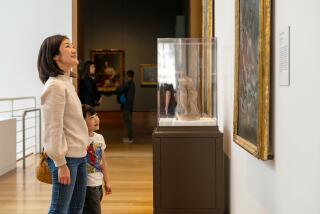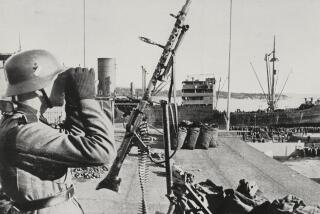National World War II Museum in New Orleans salutes the Greatest Generation
Why, of all places, is the National World War II Museum in this sultry Gulf Coast port, better known for its jazz, party beads and occasional Category 3 hurricane?
Because famed World War II historian Stephen E. Ambrose wanted it that way.
Ambrose, whose books include “Band of Brothers,” upon which the HBO miniseries of the same title was based, made his home about an hour from here, in Bay St. Louis, Miss. He knew that it was in New Orleans that industrialist Andrew Jackson Higgins and 30,000 workers built more than 20,000 Higgins boats — known in military parlance as Landing Craft, Vehicle Personnel — the ungainly, shoebox-shaped vessels that ferried U.S. troops ashore in every major amphibious assault of World War II.
Supreme Allied Cmdr. Dwight D. Eisenhower, for whom Ambrose served as official biographer, once credited Higgins as “the man who won the war for us.” So, Ambrose figured what better place than New Orleans for such a museum?
National World War II Museum, 945 Magazine St., New Orleans; (504) 528-1944, https://www.nationalww2museum.org. Open 9 a.m.-5 p.m. daily. Closed Mardi Gras Day, Thanksgiving, Christmas Eve and Christmas Day. Admission: $18; seniors, $14; children under 12, students with ID and military personnel, $9; World War II veterans, free.
In 2000, two years before he died of lung cancer, Ambrose founded the D-day Museum to honor the pivotal Allied invasion of Normandy on June 6, 1944. In 2006, it was retitled as the more inclusive National World War II Museum. Today it stands as a sobering tribute to the Greatest Generation, whose citizen-soldiers went to war and literally saved the world. The museum also is a must-see for anyone interested in better understanding why more than 400,000 of those citizen-soldiers never returned home from that war, which officially ended 65 years ago Sunday with the surrender of Japan.
I’ve read most of Ambrose’s books, and I have a relative who died in World War II — a cousin, whose B-17 bomber was shot down over France a week before D-day, is buried in the American cemetery at Omaha Beach — so I had long wanted to visit the museum. A few hours of playing hooky during a recent business trip to New Orleans afforded me the opportunity. I was not disappointed.
No shrine to combat would be complete without displaying the kit and standard-issue weapons of front-line troops. Certainly, the National World War II Museum is no exception. Here, among three floors and 35,000 square feet of exhibit space, you will find a veritable armory of mortars, machine guns, small arms and uniforms of both Allied and Axis origin. There are halftracks, jeeps, a Sherman tank, a German 88-millimeter artillery piece and a fully restored C-47 transport plane. But what distinguishes this museum are the artifacts, from wristwatches to helmets with bullet holes, that convey a vividly personal insight into the horror of battle.
Among the relics I found most poignant was the equipment belt worn on D-day by Navy corpsman Leo H. Sheer, whose landing craft was sunk on its way to Omaha Beach. Forced to swim ashore, Sheer began collecting first-aid pouches from the bodies of dead soldiers to help save the wounded. He hung six of the dead men’s pouches on his belt. Look closely: You can still see what appear to be flecks of dried blood on some of them.
Also impressive is an exhibit depicting what it was like to be on the home front in World War II, when ordinary citizens went to extraordinary lengths to take the fight to the enemy by recycling items as diverse as tin cans and chicken fat. Who knew, for example, that 30,000 razor blades melted down could make 50 rounds of .30-caliber machine-gun ammunition, or that 2,300 pairs of women’s nylons were needed for one parachute?
Located throughout the museum are darkened stations where you can sit comfortably and listen to firsthand, tape-recorded recollections of those who fought and those who supported them. Ambrose collected more than 2,000 such histories in his research. Some of the interviewees will be familiar to students of military history, among them “Band of Brothers” company commander Richard D. Winters, whose heroism on D-day while leading a masterfully executed attack on a German howitzer battery was deserving, many believe, of the Medal of Honor.
Besides its permanent exhibits, the museum features two movies in its Malcolm S. Forbes Theatre — “D-day Remembered” and the Steven Spielberg-produced “Price for Peace,” chronicling events in the Pacific from the Japanese attack at Pearl Harbor to the occupation of Japan fewer than four years later. There’s also the museum’s Solomon Victory Theater, which shows “Beyond All Boundaries,” a Tom Hanks executive produced and -narrated film that, the museum says, “plunges viewers into the 20th century’s most titanic struggle” using 4-D, a technique that “engages all the audience’s senses with digital effects, life-sized props, animation and atmospherics as well as film and sound.”
I didn’t need Hollywood theatrics to appreciate the magnitude of the struggle that was World War II. Gazing at Sheer’s blood-stained web belt was more than enough for me.
More to Read
Sign up for The Wild
We’ll help you find the best places to hike, bike and run, as well as the perfect silent spots for meditation and yoga.
You may occasionally receive promotional content from the Los Angeles Times.






